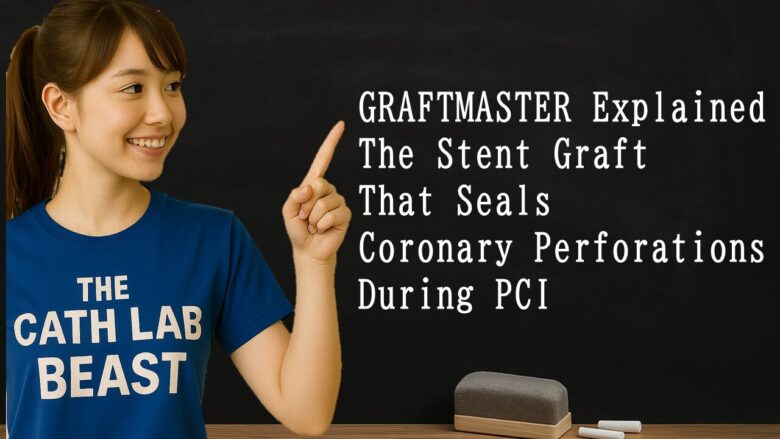Introduction
Percutaneous coronary intervention (PCI) is a cornerstone therapy for patients with ischemic heart disease. However, one of the most feared complications during PCI is coronary artery perforation. If untreated, perforation can result in cardiac tamponade and life-threatening hemodynamic compromise.
To address such emergencies, Abbott developed the GRAFTMASTER™ RX Coronary Stent Graft System. This article explains its purpose, indications in Japan, technical specifications, benefits, risks, and practical considerations for interventional cardiologists.
What is the GRAFTMASTER RX?

The GRAFTMASTER RX is a specialized coronary stent graft designed specifically to seal vessel perforations. Unlike drug-eluting or bare-metal stents, its purpose is not routine revascularization but emergency use in PCI complications.
Key Features
- Dual stent structure — Two stainless-steel stents sandwiching an ePTFE membrane to seal the perforation.
- Rapid Exchange (RX) system — Enables fast deployment in critical situations.
- Emergency focus — Serves as a life-saving tool for perforation management, not as a standard stent option.
Indications in Japan
In Japan, the GRAFTMASTER RX is approved for:
Emergency treatment of patients with coronary artery or saphenous vein graft perforations that result in uncontrollable bleeding into the pericardial space.
This strict indication means it is not intended for elective use but solely for life-threatening perforations during PCI.
Technical Specifications
| Parameter | Detail |
|---|---|
| Stent Material | Stainless steel (316L) |
| Graft Material | ePTFE membrane |
| Stent Thickness | 0.26 mm (two stent layers + ePTFE membrane) |
| Diameter Range | ~2.8 mm to 4.8 mm |
| Maximum Expanded Diameter | Up to 5.5 mm (outer diameter). Considering stent thickness, post-dilation balloon size should not exceed ~4.9 mm. |
| Lengths Available | 16 mm / 19 mm / 26 mm |
| Stent Shortening | Up to 1.6 mm at each end (maximum ~3.2 mm total) |
| Balloon Type | Semi-compliant |
| Delivery System | RX (Rapid Exchange) |
Clinical Benefits
- Immediate hemostasis — Rapid sealing of perforations to prevent tamponade.
- Quick deployment — RX system minimizes delay in emergencies.
- Adaptability — Multiple diameters and lengths for varied anatomies.
Risks and Limitations
- Limited long-term data — Emergency use limits evidence on restenosis or thrombosis.
- Allergic contraindications — Not suitable for patients allergic to stainless steel (nickel, chromium) or PTFE.
- Potential complications — Thrombosis, restenosis, or side-branch occlusion.
- Technical cautions
- Avoid balloon over-inflation beyond rated pressure.
- When multiple grafts are needed, deploy the distal graft first to reduce crossing risks.
Practical Considerations
- Device selection — Ensure the chosen size fully covers the perforation with proper margins.
- Imaging support — IVUS or OCT can confirm correct placement.
- Cath lab readiness — Because perforations are unpredictable, GRAFTMASTER should always be available in the cath lab inventory.
Conclusion
Abbott’s GRAFTMASTER RX Coronary Stent Graft System is a critical life-saving device for managing coronary perforations during PCI.
In Japan, its use is strictly limited to emergency cases, but its rapid sealing capability makes it indispensable in the catheterization lab. For interventional cardiologists, understanding the device’s indications, specifications, and technical precautions is essential for ensuring patient safety in high-risk PCI procedures.



コメント